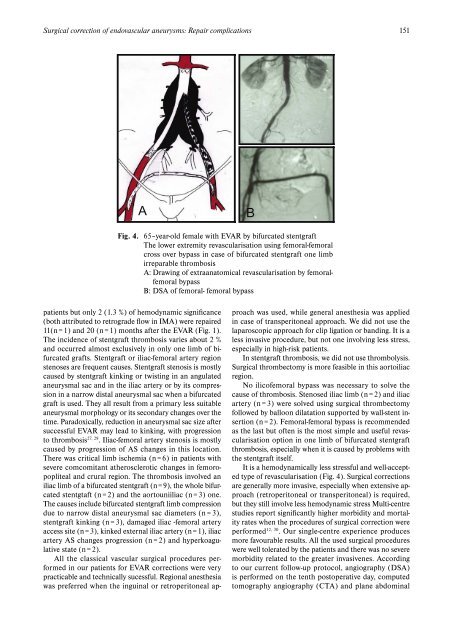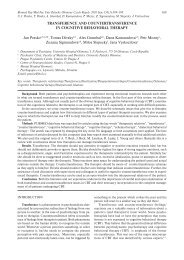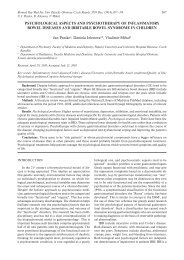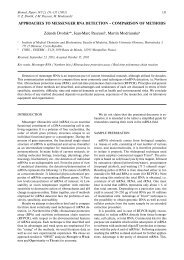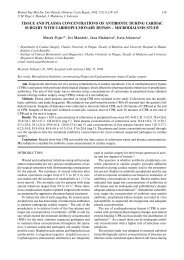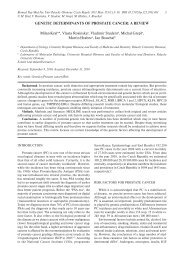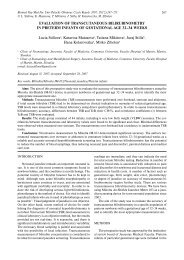SURGICAL CORRECTION OF ENDOVASCULAR ANEURYSMS ...
SURGICAL CORRECTION OF ENDOVASCULAR ANEURYSMS ...
SURGICAL CORRECTION OF ENDOVASCULAR ANEURYSMS ...
You also want an ePaper? Increase the reach of your titles
YUMPU automatically turns print PDFs into web optimized ePapers that Google loves.
Surgical correction of endovascular aneurysms: Repair complications151ABFig. 4. 65–year-old female with EVAR by bifurcated stentgraftThe lower extremity revascularisation using femoral-femoralcross over bypass in case of bifurcated stentgraft one limbirreparable thrombosisA: Drawing of extraanatomical revascularisation by femoralfemoralbypassB: DSA of femoral- femoral bypasspatients but only 2 (1.3 %) of hemodynamic significance(both attributed to retrograde flow in IMA) were repaired11(n = 1) and 20 (n = 1) months after the EVAR (Fig. 1).The incidence of stentgraft thrombosis varies about 2 %and occurred almost exclusively in only one limb of bifurcatedgrafts. Stentgraft or iliac-femoral artery regionstenoses are frequent causes. Stentgraft stenosis is mostlycaused by stentgraft kinking or twisting in an angulatedaneurysmal sac and in the iliac artery or by its compressionin a narrow distal aneurysmal sac when a bifurcatedgraft is used. They all result from a primary less suitableaneurysmal morphology or its secondary changes over thetime. Paradoxically, reduction in aneurysmal sac size aftersuccessful EVAR may lead to kinking, with progressionto thrombosis 27, 29 . Iliac-femoral artery stenosis is mostlycaused by progression of AS changes in this location.There was critical limb ischemia (n = 6) in patients withsevere comcomitant atherosclerotic changes in femoropoplitealand crural region. The thrombosis involved aniliac limb of a bifurcated stentgraft (n = 9), the whole bifurcatedstentgtaft (n = 2) and the aortouniiliac (n = 3) one.The causes include bifurcated stentgraft limb compressiondue to narrow distal aneurysmal sac diameters (n = 3),stentgraft kinking (n = 3), damaged iliac -femoral arteryaccess site (n = 3), kinked external iliac artery (n = 1), iliacartery AS changes progression (n = 2) and hyperkoagulativestate (n = 2).All the classical vascular surgical procedures performedin our patients for EVAR corrections were verypracticable and technically sucessful. Regional anesthesiawas preferred when the inguinal or retroperitoneal approachwas used, while general anesthesia was appliedin case of transperitoneal approach. We did not use thelaparoscopic approach for clip ligation or banding. It is aless invasive procedure, but not one involving less stress,especially in high-risk patients.In stentgraft thrombosis, we did not use thrombolysis.Surgical thrombectomy is more feasible in this aortoiliacregion.No ilicofemoral bypass was necessary to solve thecause of thrombosis. Stenosed iliac limb (n = 2) and iliacartery (n = 3) were solved using surgical thrombectomyfollowed by balloon dilatation supported by wall-stent insertion(n = 2). Femoral-femoral bypass is recommendedas the last but often is the most simple and useful revascularisationoption in one limb of bifurcated stentgraftthrombosis, especially when it is caused by problems withthe stentgraft itself.It is a hemodynamically less stressful and well-acceptedtype of revascularisation (Fig. 4). Surgical correctionsare generally more invasive, especially when extensive approach(retroperitoneal or transperitoneal) is required,but they still involve less hemodynamic stress Multi-centrestudies report significantly higher morbidity and mortalityrates when the procedures of surgical correction wereperformed 12, 30 . Our single-centre experience producesmore favourable results. All the used surgical procedureswere well tolerated by the patients and there was no severemorbidity related to the greater invasivenes. Accordingto our current follow-up protocol, angiography (DSA)is performed on the tenth postoperative day, computedtomography angiography (CTA) and plane abdominal


